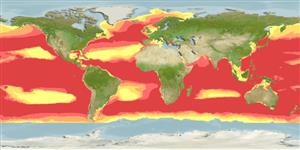Common names from other countries
>
Aulopiformes (Grinners) >
Alepisauridae (Lancetfishes)
Etymology: Alepisaurus: Greek, alepis, -idos = without scales + Greek, sauros = lizard (Ref. 45335); ferox: The specific name is derived from ferox, meaning ferocious (Ref. 6885).
More on author: Lowe.
Environment: milieu / Zona climática / intervalo de profundidade / distribution range
Ecologia
marinhas batipelágico; oceanódromo (Ref. 51887); intervalo de profundidade 0 - 1830 m (Ref. 50550). Deep-water; 84°N - 57°S, 180°W - 180°E
Circumglobal: Western Pacific (Ref. 6885, 7300); Eastern Pacific: from the Aleutian Islands to Chile, also (Ref. 2850); Western Atlantic: Gulf of Maine to the Gulf of Mexico and the Caribbean Sea, also (Ref. 7251); Eastern Atlantic (Ref. 4059). Indian Ocean (Ref. 57630). Northwest Atlantic: Canada (Ref. 5951). South China Sea and East China Sea (Ref. 74511).
Tamanho / Peso / Idade
Maturidade: Lm ? range ? - ? cm
Max length : 215 cm TL macho/indeterminado; (Ref. 7251); common length : 150 cm TL macho/indeterminado; (Ref. 5217); peso máx. publicado: 9.0 kg (Ref. 42154)
Descrição suscinta
Chaves de identificação | Morfologia | Morfometria
Espinhos dorsais (total) : 0; Raios dorsais (total) : 30 - 45; Espinhos anais: 0; Raios anais : 13 - 18; Vértebras: 47 - 52. Mouth large with two erect fangs on palatines. Dorsal fin very high, about three rays beginning with third or fourth much exerted; adipose moderate in size, over posterior part of anal insertion (Ref. 6885). Generally pale, iridescent, darker dorsally; lateral adipose keel dark; all fins dark brown or black; peritoneum black (Ref. 6885). Branchiostegal rays: 7-8 (Ref. 36025).
Body shape (shape guide): elongated; Cross section: circular.
Mainly inhabit tropical and subtropical waters; however, during the feeding period adults may migrate to the subarctic reaching as far north as Greenland, Iceland and the Bering Sea (Ref. 51887). Epipelagic- and mesopelagic, from near the surface to below 1,000 m, sometimes approaching inshore waters (Ref. 6011). Bathypelagic (Ref. 58302). Mainly nocturnal. Feeds on fishes, cephalopods, tunicates, and crustaceans (Ref. 6011). Preyed upon by opah, sharks, albacore, yellowfin tuna, and fur seals (Ref. 6885). Oviparous, with planktonic larvae (Ref. 36025). Are synchronous hermaphrodites (Ref. 84733). Occasionally consumed but of little importance due to its soft flesh (Ref. 5217). The maximum weight given is for a 167 cm FL specimen (Ref. 42154).
Ciclo de vida ou comportamento de acasalamento
Maturidade | Reprodução | Desova | Ovos | Fecundidade | Larvas
Oviparous. Gonads of adolescents are hermaphroditic, but there is no proof that the species is a functional hermaphrodite (Ref. 6011). However, further studies show that this species is a synchronous hermaphrodite where gonads consist of clearly defined and well separated ovarian and testicular regions with no indication of sequential maturation of the sex products (Ref. 84733).
Post, A., 1984. Alepisauridae. p. 494-495. In P.J.P. Whitehead, M.-L. Bauchot, J.-C. Hureau, J. Nielsen and E. Tortonese (eds.) Fishes of the north-eastern Atlantic and the Mediterranean. UNESCO, Paris. Vol. 1. (Ref. 6011)
Status na Lista Vermelha da UICN (Ref. 130435: Version 2025-1)
Ameaça para os humanos
Harmless
Uso pelos humanos
Pescarias: espécies comerciais
Ferramentas
Relatórios especiais
Baixar XML
Fontes da internet
Estimates based on models
Preferred temperature (Ref.
123201): 4.7 - 14.6, mean 8.9 °C (based on 1772 cells).
Índice de diversidade filogenética (Ref.
82804): PD
50 = 1.0000 [Uniqueness, from 0.5 = low to 2.0 = high].
Bayesian length-weight: a=0.00389 (0.00180 - 0.00842), b=3.12 (2.94 - 3.30), in cm total length, based on all LWR estimates for this body shape (Ref.
93245).
Nível Trófico (Ref.
69278): 4.0 ±0.2 se; based on diet studies.
Fishing Vulnerability (Ref.
59153): Very high vulnerability (90 of 100).
🛈
Nutrients (Ref.
124155): Calcium = 13 [4, 37] mg/100g; Iron = 0.292 [0.097, 0.916] mg/100g; Protein = 16.3 [13.1, 18.8] %; Omega3 = 0.0817 [, ] g/100g; Selenium = 33.6 [10.2, 94.9] μg/100g; VitaminA = 7.96 [0.91, 66.44] μg/100g; Zinc = 0.284 [0.147, 0.569] mg/100g (wet weight);
